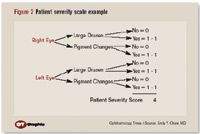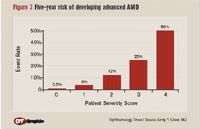Article
AMD progression rates low among African-Americans
Fort Lauderdale, FL-The proportion of African-Americans in the Age-Related Eye Disease Study (AREDS) whose disease has progressed toward either advanced age-related macular degeneration (AMD) or along the clinical AMD severity scale is less than that of non-African-Americans in the study, said Emily Y. Chew, MD.
Fort Lauderdale, FL-The proportion of African-Americans in the Age-Related Eye Disease Study (AREDS) whose disease has progressed toward either advanced age-related macular degeneration (AMD) or along the clinical AMD severity scale is less than that of non-African-Americans in the study, said Emily Y. Chew, MD.

She presented the most recent results from AREDS at the annual meeting of the Association for Research in Vision and Ophthalmology. The AREDS clinical scale for assessing 5-year risk of progression to advanced AMD is based on drusen size and retinal pigmentary abnormalities, either hyperpigmentary or depigmentary. This simplified scale is designed more for use by clinicians involved in patient care than for researchers, Dr. Chew said.

Risk factors are added from both eyes, resulting in a five-step scale (0 to 4). The patient severity score of 4 has the greatest risk, 59%, for developing advanced AMD in 5 years.
About 2% (n = 157) of the entire AREDS cohort was African-American, and 4,095 were of other racial backgrounds, mostly white, non-Hispanic. The median follow-up was 5 years, and the median age at baseline was 66 years for the African-American participants versus 69 years for the non-African-American participants.

About 5% of the African-Americans in the study had the simple scale patient score of 3 while non-Afri-can-Americans had 13%. For the most severe end of the simple scale, the rates were 2% for African-Americans and 16% for non-African-Americans, according to Dr. Chew.
Five-year rate
The 5-year rate of development of advanced AMD was also very low (1.3%) in the African-American cohort, Dr. Chew said. None of the three African-American participants with a patient severity scale score of 4 had progression, while one of eight (12.5%) with a score of 3 and one of seven (14%) with a score of 2 had progression. One additional participant had progression by the 10-year follow-up.
By comparison, in the full cohort the expected 5-year progression rates to advanced AMD were 12%, 25%, and 50%, for patients' risk scores of 2, 3, and 4, respectively.





